B is for Bread 101
“Bread is the king of the table and all else is merely the court that surrounds the king. The countries are the soup, the meat, the vegetables, the salad but bread is king.”
Louis Bromfield, American novelist (1896-1956)
Breads is one of my most favorite things to make, I love working with them, kneading, shaping and proofing gives me joy beyond measure. So B had to be breads here though I did take a poll on FB if more people wanted to see brownies here today 🙂
Bread is also something that came to be last in the baking, God knows I have made enough hockey sticks in the name of a thin loaf. I know a lot of us are scared of breads, scared of working with yeast and that is what I want to break today.
So here is Bread 101 for you today, tips and tricks and stages I have learnt over time.
I think some of the most important things one needs to take care when thinking of breads broadly is
1. Yeast
2. Flour
3. Liquid – Flour Ration
4. Kneading
5. Temperature
So lets look at each one of them
Yeast
Bread yeasts are one-celled fungi found all around us, in our kitchens and outside, in the air, in the soil, and on grains, fruits and vegetables. People have been capturing and propagating these wild yeasts for thousands of years in sourdough starters. Scientific breeding of our domestic strains of bread yeasts really started with Louis Pasteur in the 1800s.
Bread yeast ferments carbohydrates producing alcohol and carbon dioxide gas in the process. The gas bubbles, trapped within the elastic dough are what make dough rise, giving us light flavorful bread. Flavor and texture are not the only benefits. Yeast itself is an excellent source of B-complex vitamins and Thiamine and the action of fermentation makes grains more digestible (these are good reasons to prefer yeasted breads rather than quick-breads as a daily diet.)
Bread yeast is an amazingly versatile and adaptive organism: shut off its oxygen supply and it will still reproduce anaerobically; deprive it of moisture and it will go dormant, but still live. Modern yeast factories capitalize on these characteristics to produce yeast in several forms for the home and professional baker.
Active Dry Yeast is called active to distinguish it from Nutritional or Brewer’s Yeast which is also dry. Nutritional Yeast is dead; it has no leavening power. It may be a nutritious food supplement, but it has no place in breadmaking (The Laurel’s Kitchen Bread Book says that even a small amount added to dough will decrease the effectiveness of the active yeast and make gummy bread.) Its fresh yeast which has been compressed and dried until the moisture content is highly reduced. This yeast is available in the form of large granules in India, examples are Eagle, Kwality and a lot of other brands we see in our super-markets here. This kind of yeast needs to be dissolved in warm water and sugar for the yeast to be active again, this is called as proofing. Proofing is a test done to make sure the yeast is still active and good. If the yeast, fails this test, please discard and get yourself some good yeast
Instant Active Dry Yeast. the granules of their traditional yeast smaller so that dissolving in water is not necessary.
Compressed or Fresh Yeast is sold in cakes. It can be kept in a refrigerator for about 10-14 days and frozen for upto 6 months.
Conversion of one type of yeast to another –
Multiply the amount of instant yeast by 3 for the equivalent amount of fresh yeast.
Multiply the amount of active dry yeast by 2.5 for the equivalent amount of fresh yeast.
Multiply the amount of instant yeast by 1.25 for the equivalent of active dry yeast.
Wild Yeast – Take equal parts of flour and water, leave the mixture in a warm location. Then walk away and leave it along for a couple of days. When you return in a couple of days to look at it, the starter should be a frothy mixture. You’ll see how the flour and water have developed. There should be some smelly water on top, and in general, you’ll have a starter of wild yeast. Generally unpredictable though
Storage of Yeast – Instant /Instant Active/Rapid yeast will keep a year at room temperature if unopened. If opened, it will keep 6 months in the refrigerator and 12 months in the freezer. Keep yeast in its original container with the opened flap folded closed in a re-sealable plastic bag
Fresh yeast will keep for about 15 days in a refrigerator
Note : 1 package active dry yeast = about 2 1/4 teaspoons = 1/4 ounce
Flour
The flour you choose for your bread also makes a difference in the quality of the final product. To make a good bread, we need typically need flour which contains a protein called “gluten” When we knead the dough, gluten is the ingredient that makes the elasticity, holds in the gas cause by the fermenting yeast and creates the architectural plan of the bread.
The wheat berry has three basic parts: the endosperm, the germ and the bran. The germ is the embryonic plant, but is only about 2-3% of the total berry. The endosperm, which is about 75% of the berry, serves as food for the germ as it sprouts. The rest is the bran, which protects the tiny germ.
All purpose flour or our good old maida has a protein percentage of about 10% and is the most common flour used for baking breads in India. There is also a strong flour or strong maida available in bulk which most commercial bakeries use which have about 11-12% of protein which is really close to the bread flour we get abroad which has about 12-13% of protein
Remember the higher the protein content, more the gluten better the texture of the bread
Liquid – flour ratio
This plays one of the key roles in a successful bread. Be careful to not skew this ratio when you mix the dough. Be particularly careful when you are working with whole wheat flour as different kinds of whole wheat flour take different amounts of water. Unless you are using the same brand and kind of flour and the same method of measuring flour, under the same weather conditions, the liquid amount may not be the same. Also remember the liquid in the dough is not the liquid but also the butter, the liquid left by various other ingredients like onion
Kneading the dough:
This is the most critical step in bread making, one needs to use pressure but yet not kill the yeast. Also its important to knead the dough till its fully elastic and passes the window pane test. Basically when u take a piece in your hand and stretch it should not break
Recommended watch – How to knead a bread dough by hand
The right temperature – a warm, draft free place for your bread dough to rise and proof is a extremely important
Come back tomorrow for part II of bread basics, I will take you through Stages of Bread Baking and the Bread Bakers Percentage
Hope you are enjoying the A-Z of baking. Tell me what else you want to read about.










Pingback: B is for Bread 101, part 2 | Sin-A-Mon Tales
Just went through your blog Monika, amazing one..:)